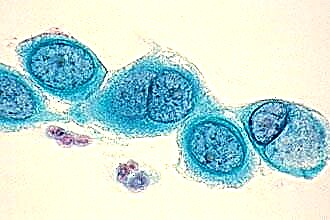Angina (tonsillitis) is an infectious-allergic pathology resulting from inflammation of the lymphoid tissue in the upper respiratory tract. Bacterial, viral and fungal pathogens can act as an etiological factor provoking the development of the disease. A decrease in local immunobiological barriers leads to an intensive reproduction of opportunistic microorganisms, as a result of which inflammation occurs.
 Why does angina appear? Infection of adults and children often occurs by airborne droplets when talking to a carrier of the infection. The key sites of invasion of the pathogenic flora are the palatine tonsils and pharynx. The local temperature in these areas corresponds to the optimal conditions for the development of streptococci, which most often act as provocateurs of acute inflammation in the lymphoid tissue of the oropharynx.
Why does angina appear? Infection of adults and children often occurs by airborne droplets when talking to a carrier of the infection. The key sites of invasion of the pathogenic flora are the palatine tonsils and pharynx. The local temperature in these areas corresponds to the optimal conditions for the development of streptococci, which most often act as provocateurs of acute inflammation in the lymphoid tissue of the oropharynx.
Pathogenesis
What are the causes of sore throat? Pathological processes in the respiratory organs are often caused by inflammation of the tonsils, which are an accumulation of lymphoid tissue. They are located directly at the junction of the digestive and airways, therefore, they are more susceptible to infection with pathogens.
Lymphoid formations have a loose structure, which facilitates the penetration of pathogens into the ENT organs. The introduction of a large number of virulent bacteria into the mucous membrane of the oropharynx leads to suppression of immunity factors, which contributes to the development of the disease. Damage to the lymphoid tissue provokes an increase in vascular permeability, as a result of which there is swelling in the throat. Infiltration of the tonsils with neutrophils and macrophages entails the melting of the ciliated epithelium, as a result of which foci of purulent inflammation are formed.
Causative agents of tonsillitis
Why does acute tonsillitis occur in adults? The key reason for the development of pathology is the multiplication of pathogenic flora in the mucous membranes of the upper respiratory tract. Pathogens enter the ENT organs by exogenous (airborne) or endogenous (hematogenous) routes. Common causative agents of the disease include:
- streptococci;
- staphylococci;
- corynebacteria;
- chlamydia;
- herpes virus;
- influenza virus;
- adenoviruses;

- rhinoviruses.
In 60% of cases, acute tonsillitis appears as a result of damage to the palatine tonsils β-hemolytic streptococcus.
With normal reactivity of the body, the number of opportunistic microorganisms in the mucous membrane of the oropharynx is limited. But in the case of a sharp decrease in local and general immunity, pathogenic agents begin to develop intensively, as a result of which intoxication is observed.
Untimely relief of catarrhal processes can cause the development of severe complications, in particular chronic tonsillitis, otitis media, meningitis, pyelonephritis, etc.
Etiological factors
In a small amount, opportunistic microbes, fungi and viruses are always found in the mucous membrane of the ENT organs. A sharp decrease in the body's resistance can contribute to an increase in the number of pathogens. The following etiological factors can provoke the development of an infectious disease in adults:
- hypothermia;
- tobacco smoking;
- avitaminosis;
- mechanical damage to the throat;
- chronic diseases;
- abuse of hormonal drugs;
- constitutional predisposition;
- hypoplasia of lymphoid tissues.
As a rule, the causes of angina lie in a decrease in local immunity due to dysfunction of the palatine tonsils (tonsils). They are involved in the synthesis of protective cells that control the development of pathogens. Failures in the work of lymphoid formations inevitably lead to a decrease in local immunity, which is fraught with the development of pathogenic flora.
Psychosomatic causes
Psychosomatics is a promising direction in psychology and official medicine, which studies the influence of psychological factors on the occurrence of somatic pathologies. Not so long ago, scientists came to the conclusion that psychological reasons lie at the heart of the development of any infectious disease. Currently, experts are investigating the relationship between somatic pathologies and constitutional characteristics of patients.
According to the new theory, diseases arise as a result of psychological disorders caused by mental conflicts in the subconscious and consciousness of a person. Organic causes of the development of pathologies are secondary and are the result of psychosomatic failures. What psychological factors can trigger the development of tonsillitis?
According to psychologists and specialists in the field of psychosomatics, infection of the upper respiratory tract is associated with:
- anger;
- irritability;
- containment of emotions;
- constant stress;
- lack of attention;
- social maladjustment.
Acute tonsillitis occurs 4 times more often in children in whose families their parents do not pay enough attention to them.
Viral sore throat
A viral infection in adults most often occurs as a result of general intoxication of the body and upset of the gastrointestinal tract. For this reason, with the development of the disease, patients may complain of abdominal cramping, loose stools, constant nausea and fever. The viral flora, localized in the upper respiratory tract, is most often represented by:
- rhinoviruses;
- syncytial virus;
- coronaviruses;
- herpes virus;
- adenoviruses.
Untimely destruction of a viral infection is fraught with a specific change in the biochemical composition of the blood.
Dysfunction of the gastrointestinal tract is caused by general intoxication of the body and a decrease in the number of beneficial bacteria in the small intestine. If the pathology was provoked by rhinoviruses, conjunctivitis, severe runny nose and lacrimation can join the standard manifestations of the infection. Local symptoms of acute tonsillitis in adults are hyperemia of the oropharyngeal mucosa, vesicular rashes on the tonsils, discomfort in the throat.
Bacterial sore throat
Bacterial (purulent) tonsillitis is the most common form of otolaryngological disease, which occurs as a result of the development of coccal flora in the lymphoid tissue of the oropharynx. As a rule, the causative agent of the infection is streptococcus, which begins to actively reproduce when favorable conditions appear: trauma to the mucous throat, smoking, hypothermia, vitamin deficiency, etc.
More than 15% of people are latent carriers of streptococcal infection, which can infect a person with reduced immune reactivity.
Bacterial tonsillitis in 30% of cases is complicated, due to the rapid spread of pathogenic flora in the airways. Late passage of antimicrobial therapy is fraught with the development of otitis media and chronic tonsillitis. The onset of sluggish inflammation contributes to the destruction of lymphoid tissue, which can lead to sepsis.
Sore throat
Candidal infection in adults appears as a result of the uncontrolled development of fungal flora in the lymphoid formations of the pharynx. The causative agent of the infection is often the yeast-like fungus Candida albicans.Typically, a fungal infection occurs due to a decrease in local immunity, which is associated with excessive use of antibiotics and glucocorticoids.
Candidal infection in adults and children occurs as a complication of other pathologies, the treatment of which was accompanied by the intake of antimicrobial agents. The general symptoms of the disease are not expressed enough, which complicates the diagnosis and the passage of antifungal therapy. With a thorough pharyngoscopic examination, small purulent foci are found on the mucous membrane of the tonsils and pharynx. With the progression of the pathology, a purulent plaque forms on the inner surface of the cheeks and tongue.




